|
Edward Teach (c. 1680 – 22 November 1718), better known as
Blackbeard, was a notorious English pirate who operated around the West Indies and the eastern coast of the American colonies. Although little is known about his early life, he was likely born in Bristol, England. He may have been a sailor on privateer ships during Queen Anne's War before settling on the
Caribbean island of New Providence, a base for Captain Benjamin Hornigold, whose crew Teach joined sometime around 1716. Hornigold placed him in command of a sloop he had captured, and the two engaged in numerous acts of
piracy. Their numbers were boosted by the addition to their fleet of two more ships, one of which was commanded by Stede Bonnet, but toward the end of 1717 Hornigold retired from
piracy, taking two vessels with him.
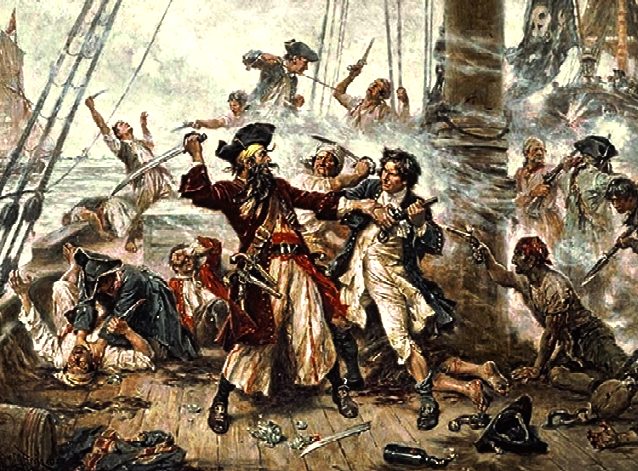
Teach captured a French merchant vessel, renamed her
Queen Anne's
Revenge, and equipped her with 40 guns. He became a renowned pirate, his cognomen derived from his thick black beard and fearsome appearance; he was reported to have tied lit fuses under his hat to frighten his enemies. He formed an alliance of pirates and blockaded the port of Charleston, South Carolina. After successfully ransoming its inhabitants, he ran Queen Anne's Revenge aground on a sandbar near Beaufort, North Carolina. He parted company with Bonnet, settling in Bath Town, where he accepted a royal pardon. But he was soon back at sea and attracted the attention of Alexander Spotswood, the Governor of Virginia. Spotswood arranged for a party of soldiers and sailors to try to capture the pirate, which they did on 22 November 1718. During a ferocious battle, Teach and several of his crew were killed by a small force of sailors led by Lieutenant Robert Maynard.
A shrewd and calculating leader, Teach spurned the use of force, relying instead on his fearsome image to elicit the response he desired from those he robbed. Contrary to the modern-day picture of the traditional tyrannical pirate, he commanded his vessels with the permission of their crews and there is no known account of his ever having harmed or murdered those he held captive. He was romanticised after his death and became the inspiration for a number of pirate-themed works of fiction across a range of genres.
Early life
Little is known about Blackbeard's early life. It is commonly believed that at the time of his death he was between 35 and 40 years old and thus born in about
1680. In contemporary records his name is most often given as Blackbeard, Edward Thatch, or Edward Teach and it is the last that today is most often used. However, several spellings of his surname exist
- Thatch, Thach, Thache, Thack, Tack, Thatche and Theach. One early source claims that his surname was Drummond, but the lack of any supporting documentation makes this unlikely. Pirates habitually used fictitious surnames while engaged in the business of piracy, so as not to tarnish the family name, and this makes it unlikely that Teach's real name will ever be
known.
The 17th-century rise of Britain's American colonies and the rapid 18th-century expansion of the Atlantic slave trade had made Bristol an important international sea port, and Teach was most likely raised in what was the second-largest city in
England. He could almost certainly read and write; he communicated with merchants and when killed had in his possession a letter addressed to him by the Chief Justice and Secretary of the Province of Carolina, Tobias Knight. The author Robert Lee speculated that Teach may therefore have been born into a respectable, wealthy
family. He may have arrived in the Caribbean in the last years of the 17th century, on a merchant vessel (possibly a slave
ship). The 18th-century author Charles Johnson claimed that Teach was for some time a sailor operating from Jamaica on privateer ships during Queen Anne's War, and that "he had often distinguished himself for his uncommon boldness and personal
courage". At what point during the war Teach joined the fighting is, in keeping with the record of most of his life before he became a pirate,
unknown.
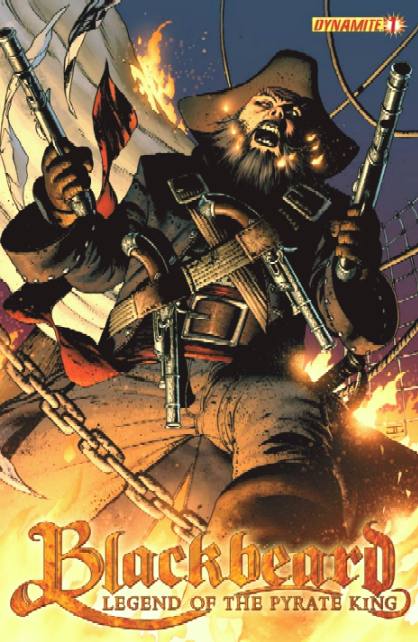
New Providence
With its history of colonialism, trade and piracy, the West Indies was the setting for many 17th and 18th-century maritime incidents. The privateer-turned-pirate Henry Jennings and his followers decided, early in the 18th century, to use the then uninhabited island of New Providence as a base for their operations; it was within easy reach of the Florida Strait and its busy shipping lanes, which were filled with European vessels crossing the Atlantic. New Providence's harbour could easily accommodate hundreds of ships, and was too shallow for the
Royal Navy's larger vessels to navigate. The island then was not the popular tourist destination it later became; the author George Woodbury described it as "no city of homes; it was a place of temporary sojourn and refreshment for a literally floating population," continuing, "The only permanent residents were the piratical camp followers, the traders, and the hangers-on; all others were
transient." Law and order were unheard of; in New Providence, pirates found a welcome
respite.
Teach was one of those who came to enjoy the island's benefits. Probably shortly after the signing of the Treaty of Utrecht, he moved there from Jamaica, and with most privateers once involved in the war, became involved in piracy. Possibly about 1716, he joined the crew of Captain Benjamin Hornigold, a renowned pirate who operated from New Providence's safe waters. In 1716 Hornigold placed Teach in charge of a sloop he had taken as a
prize. In early 1717, Hornigold and Teach, each captaining a sloop, set out for the mainland. They captured a boat carrying 120 barrels of flour out of Havana, and shortly thereafter took 100 barrels of wine from a sloop out of Bermuda. A few days later they stopped a vessel sailing from Madeira to Charleston, South Carolina. Teach and his quartermaster, William
Howard, may at this time have struggled to control their crews. By then they had probably developed a taste for Madeira wine, and on 29 September near Cape Charles all they took from the Betty of Virginia was her cargo of Madeira, before they scuttled her with the remaining
cargo.
It was during this cruise with Hornigold that the earliest known report of Teach was made, in which he is recorded as a pirate in his own right, in command of a large crew. In a report made by a Captain Mathew Munthe on an anti-piracy patrol for North Carolina, "Thatch" was described as operating "a sloop 6 gunns [sic] and about 70
men". In September Teach and Hornigold encountered Stede Bonnet, a landowner and military officer from a wealthy family who had turned to piracy earlier that year. Bonnet's crew of about 70 were reportedly dissatisfied with his command, so with Bonnet's permission, Teach took control of his ship Revenge. The pirates' flotilla now consisted of three ships; Teach on Revenge, Teach's old sloop and Hornigold's Ranger. By October, another vessel had been captured and added to the small
fleet. The sloops Robert of Philadelphia and Good Intent of Dublin were stopped on 22 October 1717, and their cargo holds
emptied.
As a former British privateer, Hornigold attacked only his old enemies, but for his crew, the sight of British vessels filled with valuable cargo passing by unharmed became too much, and at some point toward the end of 1717 he was demoted. Whether Teach had any involvement in this decision is
unknown, but Hornigold quickly retired from piracy. He took Ranger and one of the sloops, leaving Teach with Revenge and the remaining
sloop. The two never met again, and with many other occupants of New Providence, Hornigold accepted the King's pardon from Woodes Rogers in June the following
year.

Blackbeard
On 28 November Teach's two ships attacked a French merchant vessel off the coast of Saint Vincent. They each fired a broadside across its bulwarks, killing several of its crew, and forcing its captain to
surrender. The ship was La Concorde of Saint-Malo, a large French guineaman carrying a cargo of slaves. Teach and his crews sailed the vessel south along Saint Vincent and the Grenadines to Bequia, where they disembarked her crew and cargo, and converted the ship for their own use. The crew of La
Concorde were given the smaller of Teach's two sloops, which they renamed Mauvaise Rencontre (Bad Meeting), and sailed for Martinique. Teach may have recruited some of their slaves, but the remainder were left on the island and were later recaptured by the returning crew of Mauvaise
Rencontre.
Teach immediately renamed La Concorde as Queen Anne's Revenge and equipped her with 40 guns. In late November, near Saint Vincent, he attacked the Great Allen. After a lengthy engagement, he forced the large and well-armed merchant ship to surrender. He ordered her to move closer to the shore, disembarked her crew and emptied her cargo holds, and then burned and sank the vessel. The incident was chronicled in the Boston News Letter, which called Teach the commander of a "French ship of 32 Guns, a Briganteen of 10 guns and a Sloop of 12 guns." When or where Teach collected the ten gun Briganteen is unknown, but by that time he may have been in command of at least 150 men split between three
vessels.
On 5 December 1717 Teach stopped the merchant sloop Margaret off the coast of Crab Island, near Anguilla. Her captain, Henry Bostock, and crew, remained Teach's prisoners for about eight hours, and were forced to watch as their sloop was ransacked. Bostock, who had been held aboard Queen Anne's Revenge, was returned unharmed to Margaret and was allowed to leave with his
crew. He returned to his base of operations on Saint Christopher Island and reported the matter to Governor Walter Hamilton, who requested that he sign an affidavit about the encounter. Bostock's deposition details Teach's command of two vessels: a sloop and a large French guineaman, Dutch-built, with 36 cannon and a crew of 300 men. The captain believed that the larger ship carried valuable gold dust,
silver plate, and "a very fine cup" supposedly taken from the commander of Great
Allen. Teach's crew had apparently informed Bostock that they had destroyed several other vessels, and that they intended to sail to Hispaniola and lie in wait for an expected Spanish armada, supposedly laden with money to pay the garrisons. Bostock also claimed that Teach had questioned him about the movements of local ships, but also that he had seemed unsurprised when Bostock told him of an expected royal pardon from London for all
pirates.
So our Heroe, Captain Teach, assumed the Cognomen of Black-beard, from that large Quantity of Hair, which, like a frightful Meteor, covered his whole Face, and frightened
America more than any Comet that has appeared there a long Time. This Beard was black, which he suffered to grow of an extravagant Length; as to Breadth, it came up to his Eyes; he was accustomed to twist it with Ribbons, in small Tails, after the Manner of our Ramilies Wiggs, and turn them about his Ears
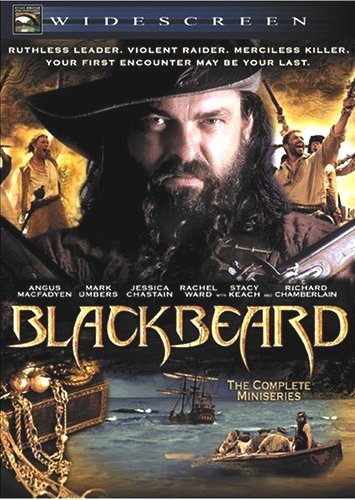
Charles Johnson
Bostock's deposition describes Teach as a "tall spare man with a very black beard which he wore very long". It is the first recorded account of Teach's appearance and is the source of his cognomen,
Blackbeard. Later descriptions mention that his thick black beard was braided into pigtails, sometimes tied in with small coloured ribbons. Johnson (1724) described him as "such a figure that imagination cannot form an idea of a fury from hell to look more frightful." Whether Johnson's description was entirely truthful or embellished is unclear, but it seems likely that Teach understood the value of appearances; better to strike fear into the heart of one's enemies, than rely on bluster
alone. Teach was tall, with broad shoulders. He wore knee-length boots and dark clothing, topped with a wide hat and sometimes a long coat of brightly-coloured silk or velvet. Johnson also described Teach in times of battle as wearing "a sling over his shoulders, with three brace of pistols, hanging in holsters like bandoliers; and stuck lighted matches under his
hat",[nb 3] the latter apparently to emphasise the fearsome appearance he wished to present to his
enemies. Despite his ferocious reputation though, there are no verified accounts of his ever having murdered or harmed those he held
captive. Teach may have used other aliases; on 30 November, the Monserrat Merchant encountered two ships and a sloop, commanded by a Captain Kentish and Captain Edwards (the latter a known alias of Stede
Bonnet).
Enlargement of Teach's fleet
Teach's movements between late 1717 and early 1718 are not known. He and Bonnet were probably responsible for an attack off Sint Eustatius in December 1717. Henry Bostock claimed to have heard the pirates say they would head toward the Spanish-controlled Samaná Bay in Hispaniola, but a cursory search revealed no pirate activity. Captain Hume of HMS Scarborough reported on 6 February that a "Pyrate Ship of 36 Guns and 250 men, and a Sloop of 10 Guns and 100 men were Said to be Cruizing amongst the Leeward Islands". Hume reinforced his crew with musket-armed soldiers and joined up with HMS Seaford to track the two ships, to no avail, though they discerned that the two ships had sunk a French vessel off St Christopher Island, and reported also that they had last been seen "gone down the North side of Hispaniola". Although no confirmation exists that these two ships were controlled by Teach and Bonnet, author Angus Konstam believes it very likely they
were.
In March 1718, while taking on water at Turneffe Island east of Belize, both ships spotted a sloop from Jamaica, Adventure, making for the harbour. She was quickly stopped and her captain, David Harriot, invited to join the pirates. Harriot and his crew accepted the invitation, and Teach sent over a crew to run Adventure. They sailed for the Bay of Honduras, where they added another ship and four sloops to their
flotilla. On 9 April Teach's enlarged fleet of ships looted and burnt Protestant Caesar. His fleet then sailed to Grand Cayman where they captured a "small
turtler". Teach probably sailed toward Havana, where he may have captured a small Spanish vessel that had left the Cuban port. They then sailed to the wrecks of the 1715 Spanish fleet, off the western coast of Florida. There Teach disembarked the crew of the captured Spanish sloop, before proceeding north to the port of Charleston, South Carolina, attacking three vessels along the
way.
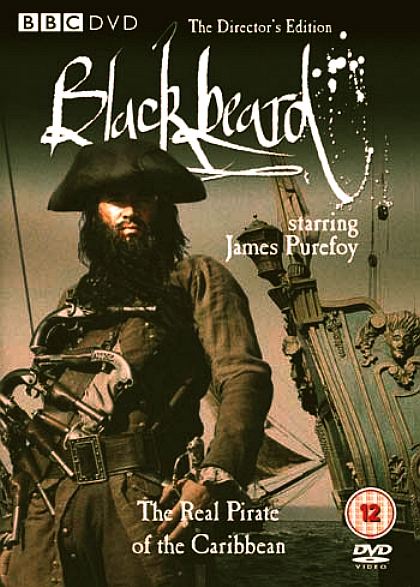
Blockade of Charleston
By May 1718 Teach had awarded himself the rank of Commodore and was at the height of his power. Late that month his flotilla blockaded the port of Charleston (then known as Charles Town) in South Carolina. All vessels entering or leaving the port were stopped, and as the town had no guard
ship, its pilot boat was the first to be captured. Over the next five or six days about nine vessels were stopped and ransacked as they attempted to sail past Charleston Bar, where Teach's fleet was anchored. One such ship, headed for London with a group of prominent Charleston citizens which included Samuel Wragg (a member of the Council of the Province of Carolina), was the Crowley. Her passengers were questioned about the vessels still in port and then locked below decks for about half a day. Teach informed the prisoners that his fleet required medical supplies from the colonial government of South Carolina, and that if none were forthcoming, all prisoners would be executed, their heads sent to the Governor and all captured
ships
burnt.
Wragg agreed to Teach's demands, and a Mr Marks and two pirates were given two days to collect the drugs. Teach moved his fleet, and the captured ships, to within about five or six leagues from land. Three days later a messenger, sent by Marks, returned to the fleet; Marks's boat had capsized and delayed their arrival in Charleston. Teach granted a reprieve of two days, but still the party did not return. He then called a meeting of his fellow sailors and moved eight ships into the harbour, causing panic within the town. When Marks finally returned to the fleet, he explained what had happened. On his arrival he had presented the pirates' demands to the Governor and the drugs had been quickly gathered, but the two pirates sent to escort him had proved difficult to find; they had been busy drinking with friends and were finally discovered,
drunk.
Teach kept to his side of the bargain and released the captured ships and his prisoners
- albeit relieved of their valuables, including the fine clothing some had
worn.
Beaufort Inlet
Whilst at Charleston, Teach learned that Woodes Rogers had left England with several men-of-war, with orders to purge the West Indies of pirates. Teach's flotilla sailed northward along the Atlantic coast and into Topsail Inlet (commonly known as Beaufort Inlet), off the coast of North Carolina. There they intended to careen their ships to scrape their hulls, but Queen Anne's Revenge ran aground on a sandbar, cracking her main-mast and severely damaging many of her timbers. Teach ordered several sloops to throw ropes across the flagship in an attempt to free her. A sloop commanded by Israel Hands of Adventure also ran aground, and both vessels appeared to be damaged beyond
repair, leaving only Revenge and the captured Spanish
sloop.
Teach had at some stage learnt of the offer of a royal pardon and probably confided in Bonnet his willingness to accept it. The pardon was open to all pirates who surrendered on or before 5 September 1718, but contained a caveat stipulating that immunity was offered only against crimes committed before 5 January. Although in theory this left Bonnet and Teach at risk of being hanged for their actions at Charleston Bar, most authorities could waive such conditions. Teach thought that Governor Charles Eden was a man he could trust, but to make sure, he waited to see what would happen to another
captain. Bonnet left immediately on a small sailing
boat for Bath Town, where he surrendered to Governor Eden, and received his pardon. He then travelled back to Beaufort Inlet to collect the Revenge and the remainder of his crew, intending to sail to Saint Thomas Island to receive a commission. Unfortunately for him, Teach had stripped the vessel of its valuables and provisions, and had marooned its crew; Bonnet set out for revenge, but was unable to find him. He and his crew returned to piracy and were captured on 27 September 1718 at the mouth of the Cape Fear River. All but four were tried and hanged in
Charleston.
The author Robert Lee surmised that Teach and Hands intentionally ran the ships aground to reduce the fleet's crew complement, increasing their share of the spoils. During the trial of Bonnet's crew, Revenge's boatswain Ignatius Pell testified that "the ship was run ashore and lost, which Thatch [Teach] caused to be
done." Lee considers it plausible that Teach let Bonnet in on his plan to accept a pardon from Governor Eden. He suggested that Bonnet do the same, and as war between the Quadruple Alliance of 1718 and Spain was threatening, to consider taking a privateer's commission from
England. Lee suggests that Teach also offered Bonnet the return of his ship
Revenge. Konstam (2007) proposes a similar idea, explaining that Teach began to see Queen Anne's Revenge as something of a liability; while a pirate fleet was anchored, news of this was sent to neighbouring towns and colonies, and any vessels nearby would delay sailing. It was prudent therefore for Teach not to linger for too long, although wrecking the ship was a somewhat extreme
measure.
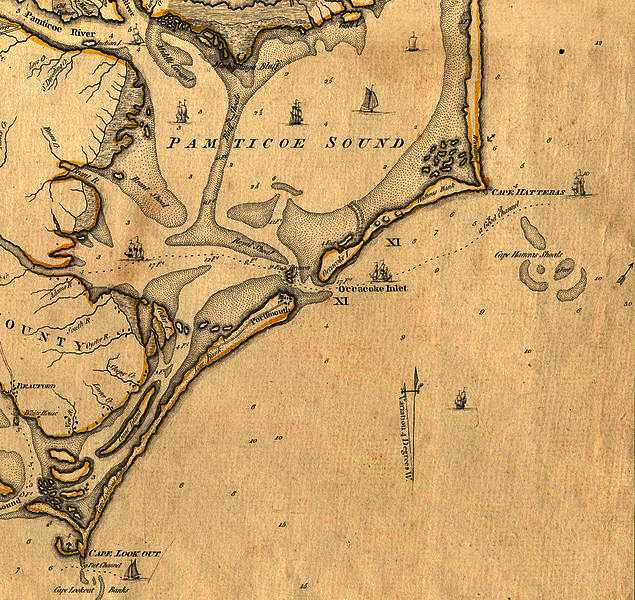
A map of the area around Ocracoke Inlet, 1775
Pardon
Before sailing northward on his remaining sloop to Ocracoke Inlet, Teach marooned about 25 men on a small sandy island about a league from the mainland. He may have done this to stifle any protest they made, if they guessed their captain's plans. Bonnet rescued them two days
later. Teach continued on to Bath, where in June 1718—only days after Bonnet had departed with his pardon—he and his much-reduced crew received their pardon from Governor
Eden.
He settled in Bath, on the eastern side of Bath Creek at Plum Point, near Eden's home. During July and August he travelled between his base in the town and his sloop off Ocracoke. Johnson's account states that he married the daughter of a local plantation owner, although there is no supporting evidence for this. Eden gave Teach permission to sail to St Thomas to seek a commission as a privateer (a useful way of removing bored and troublesome pirates from the small settlement), and Teach was given official title to his remaining sloop, which he renamed Adventure. By the end of August he had returned to piracy, and in the same month the Governor of
Pennsylvania issued a warrant for his arrest, but by then Teach was probably operating in Delaware Bay, some distance away. He took two
French ships leaving the Caribbean, moved one crew across to the other, and sailed the remaining ship back to
Ocracoke. In September he told Eden that he had found the French ship at sea, deserted. A Vice Admiralty Court was quickly convened, presided over by Tobias Knight and the Collector of Customs. The ship was judged as a derelict found at sea, and of its cargo 20 hogsheads of sugar were awarded to Knight and sixty to Eden; Teach and his crew were given what remained in the vessel's
hold.
Ocracoke Inlet was Teach's favourite anchorage. It was a perfect vantage point from which to view ships travelling between the various settlements of northeast Carolina, and it was from there that Teach first spotted the approaching ship of Charles Vane, another English pirate. Several months earlier Vane had rejected the pardon brought by Woodes Rogers and escaped the men-of-war the English captain brought with him to Nassau. He had also been pursued by Teach's old commander, Benjamin Hornigold, who was by then a pirate hunter. Teach and Vane spent several nights on the southern tip of Ocracoke Island, accompanied by such notorious figures as Israel Hands, Robert Deal and Calico
Jack.
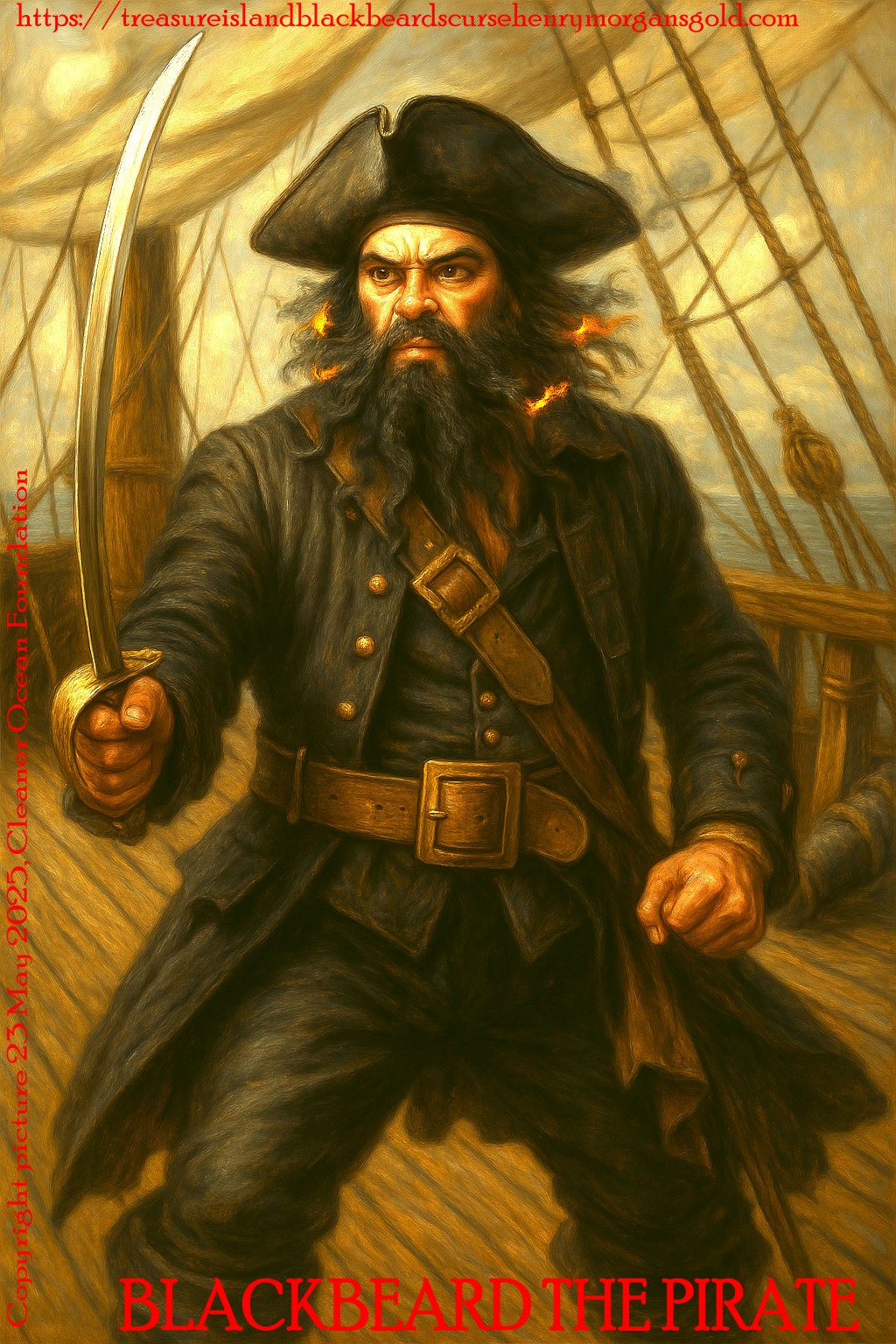
Alexander Spotswood
As it spread throughout the neighbouring colonies, the news of Teach and Vane's impromptu party worried the Governor of Pennsylvania enough to send out two sloops to capture the
pirates. They were unsuccessful, but Governor of Virginia
Alexander Spotswood was also concerned that the supposedly retired freebooter and his crew were living in nearby North Carolina. Some of Teach's former crew had already moved into several Virginian seaport towns, prompting Spotswood to issue a proclamation on 10 July, requiring all former pirates to make themselves known to the authorities, to give up their arms and to not travel in groups larger than three. As head of a Crown colony, Spotswood viewed the proprietary colony of North Carolina with contempt; he had little faith in the ability of the Carolinians to control the pirates, who he suspected would be back to their old ways, disrupting Virginian commerce, as soon as their money ran
out.
Blackbeard the Pirate: this was published in the General History of the Pyrates, 1725.
Spotswood learnt that William Howard, the former quartermaster of Queen Anne's Revenge, was in the area, and believing that he might know of Teach's whereabouts had the pirate and his two slaves arrested. Spotswood had no legal authority to have pirates
tried, and as a result, Howard's attorney, John Holloway, brought charges against Captain Brand of HMS Lyme, where Howard was imprisoned. He also sued on Howard's behalf for damages of £500, claiming wrongful
arrest.
Spotswood's council claimed that Teach's presence was a crisis and that under a statute of William III, the governor was entitled to try Howard without a jury. The charges referred to several acts of piracy supposedly committed after the pardon's cut-off date, in "a sloop belonging to ye subjects of the King of Spain", but ignored the fact that they took place outside Spotswood's jurisdiction and in a vessel then legally owned. Another charge cited two attacks, one of which was the capture of a slave ship off Charleston Bar, from which one of Howard's slaves was presumed to have come. Howard was sent to await trial before a Court of Vice-Admiralty, on the charge of piracy, but Brand and his colleague, Captain Gordon (of HMS Pearl) refused to serve with Holloway
present. Incensed, Holloway had no option but to stand down, and was replaced by the Attorney General of Virginia, John Clayton, who Spotswood described as "an honester man [than
Holloway]". Howard was found guilty and sentenced to be hanged, but was saved by a commission from London, which directed Spotswood to pardon all acts of piracy committed by surrendering pirates before 23 July
1718.
Meanwhile, Spotswood had obtained from Howard valuable information on Teach's
whereabouts, and he planned to send his forces across the border into North Carolina to capture him.[63] He gained the support of two men keen to discredit North Carolina's Governor—Edward Moseley and Colonel Maurice Moore. He also wrote to the Lords of Trade , suggesting that the Crown might benefit financially from Teach's capture. Spotswood personally financed the operation, possibly believing that Teach had fabulous treasures hidden away. He ordered Captains Gordon and Brand of HMS
Pearl and HMS Lyme to travel overland to Bath. Lieutenant Robert Maynard of HMS Pearl was given command of two commandeered sloops, to approach the town from the
sea. An extra incentive for Teach's capture was the offer of a reward from the Assembly of Virginia, over and above any that might be received from the
Crown.
Maynard took command of the two armed sloops on 17 November. He was given 57 men—33 from HMS Pearl and 24 from HMS Lyme. Maynard and the detachment from HMS Pearl took the larger of the two vessels and named her Jane; the rest took Ranger, commanded by one of Maynard's officers, a Mister Hyde. Some from the two ships' civilian crews remained aboard. They sailed from Kecoughtan, along the James River, on 17
November. The two sloops moved slowly, giving Brand's force time to reach Bath. Brand set out for North Carolina six days later, arriving within three miles of Bath on 23 November. Included in Brand's force were a number of North Carolinians, including Colonel Moore and Captain Jeremiah Vail, sent to put down any local objection to the presence of foreign soldiers. Moore went into the town to see if Teach was there, reporting back that he was not, but that the pirate was expected at "every minute." Brand then went to Governor Eden's home and informed him of his purpose. The next day, Brand sent two canoes down Pamlico River to Ocracoke Inlet, to see if Teach could be seen. They returned two days later and reported on what eventually
transpired.
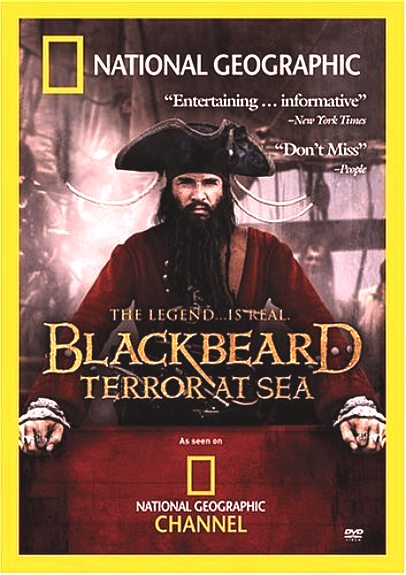
Last battle
Maynard found the pirates anchored on the inner side of Ocracoke Island, on the evening of 21
November. He had ascertained their position from ships he had stopped along his journey, but unfamiliar with the local channels and shoals he decided to wait until the following morning to make his attack. He stopped all traffic from entering the inlet—preventing any warning of his presence—and posted a lookout on both sloops to ensure that Teach could not escape to
sea. On the other side of the island, Teach was busy entertaining guests and had not set a lookout. With Israel Hands ashore in Bath with about 24 of Adventure's sailors, he also had a much-reduced crew. Johnson (1724) reported that the pirate had "no more than twenty-five men on board" and that he "gave out to all the vessels that he spoke with that he had
forty". "Thirteen white and six Negroes", was the number later reported by Brand to the
Admiralty.
At daybreak, preceded by a small boat taking soundings, Maynard's two sloops entered the channel. The small craft was quickly spotted by Adventure and fired at as soon as it was within range of her guns. While the boat made a quick retreat to the Jane, Teach cut the Adventure's anchor cable. His crew hoisted the sails and the Adventure manoeuvred to point her starboard guns toward Maynard's sloops, which were slowly closing the
gap. Hyde moved Ranger to the port side of Jane and the Union flag was unfurled on each ship. Adventure then turned toward the beach of Ocracoke Island, heading for a narrow
channel. What happened next is uncertain. Johnson claimed that there was an exchange of small-arms fire following which Adventure ran aground on a sandbar, while Maynard anchored and then lightened his ship to pass over the obstacle. Another version claimed that Jane and Ranger ran aground, although Maynard made no mention of this in his
log.
Damn you for Villains, who are you? And, from whence came you? The Lieutenant made him Answer, You may see by our Colours we are no Pyrates. Black-beard bid him send his Boat on Board, that he might see who he was; but Mr. Maynard reply'd thus; I cannot spare my Boat, but I will come aboard of you as soon as I can, with my Sloop. Upon this, Black-beard took a Glass of Liquor and drank to him with these Words: Damnation seize my Soul if I give you Quarters, or take any from you. In Answer to which, Mr. Maynard told him, That he expected no Quarters from him, nor should he give him any.
Reported exchange of views between Teach and
Maynard
What is certain though is that Adventure turned her guns on the two ships and fired. The broadside was devastating; in an instant, Maynard had lost as much as a third of his forces. About 20 on Jane were either wounded or killed and 9 on Ranger. Hyde was dead and his second and third officers either dead or seriously injured. His sloop was so badly damaged that it played no further role in the
attack. Again, contemporary accounts of what happened next are confused, but small-arms fire from Jane may have cut Adventure's jib sheet, causing her to lose control and run onto the sandbar. In the aftermath of Teach's overwhelming attack, Jane and Ranger may also have been grounded; the battle thenceforth would have become a race to see who could float their ship
first.
Capture of the Pirate, Blackbeard, 1718, Jean Leon Gerome Ferris, painted in 1920
The lieutenant had kept many of his men below deck and in anticipation of being boarded told them to prepare for close fighting. Teach watched as the gap between the vessels closed, and ordered his men to be ready. The two vessels contacted one another as the Adventure's grappling hooks hit their target and several grenades, made from powder and shot-filled bottles and ignited by fuses, broke across the sloop's deck. As the smoke cleared, Teach led his men aboard, buoyant at the sight of Maynard's apparently empty ship, his men firing at the small group formed by the lieutenant and his men at the
stern.
The rest of Maynard's men then burst from the hold, shouting and firing. The plan to surprise Teach and his crew worked; the pirates were apparently taken aback at the assault. Teach rallied his men and the two groups fought across the deck, which was already slick with blood from those
killed or injured by Teach's broadside. Maynard and Teach fired their flintlocks at each other, then threw them away. Teach drew his cutlass and managed to break Maynard's sword. Against superior training and a slight advantage in numbers, the pirates were pushed back toward the bow, allowing the Jane's crew to surround Maynard and Teach, who was by then completely
isolated. As Maynard drew back to fire once again, Teach moved in to attack him, but was slashed across the neck by one of Maynard's men. Badly wounded, he was then attacked and killed by several more of Maynard's crew. The remaining pirates quickly surrendered. Those left on the Adventure were captured by the Ranger's crew, including one who planned to set fire to the powder room and blow up the ship. Varying accounts exist of the battle's list of casualties; Maynard reported that 8 of his men and 12 pirates were killed. Brand reported that 10 pirates and 11 of Maynard's men were killed. Spotswood claimed ten pirates and ten of the King's men
dead.
Edward Teach's severed head hangs from Maynard's bowsprit, as pictured in Charles Elles's The Pirates Own Book (1837)
Maynard later examined Teach's body, noting that it had been shot no fewer than five times and cut about twenty. He also found several items of correspondence, including a letter to the pirate from Tobias Knight. Teach's corpse was thrown into the inlet while his head was suspended from the bowsprit of Maynard's sloop (so the reward could be
collected).
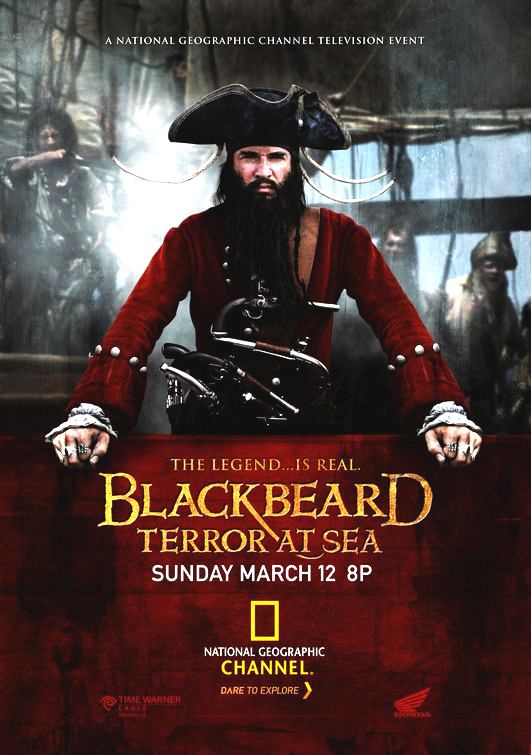
Legacy
Lieutenant Maynard remained at Ocracoke for several more days, making repairs and burying the
dead. Teach's loot - sugar, cocoa, indigo and
cotton - found "in pirate sloops and ashore in a tent where the sloops lay", was sold at auction along with
sugar and cotton found in Tobias Knight's barn, for £2,238. Governor Spotswood used a portion of this to pay for the entire operation. The prize money for capturing Teach was to have been about
£400, but it was split between the crews of HMS Lyme and HMS Pearl. As Captain Brand and his troops had not been the ones fighting for their lives, Maynard thought this extremely unfair. He lost much of any support he may have had though when it was discovered that he and his crew had helped themselves to about £90 of Teach's booty. The two companies did not receive their prize money for another four
years, and despite his bravery Maynard was not promoted; instead, he faded into
obscurity.
The remainder of Teach's crew and former associates were found by Brand, in
Bath, and were transported to Williamsburg, Virginia, where they were jailed on charges of piracy. Several were black, prompting Spotswood to ask his council what could be done about "the Circumstances of these Negroes to exempt them from undergoing the same Tryal as other pirates." Regardless, the men were tried with their comrades in Williamsburg's Capitol building, under admiralty law, on 12 March 1719. No records of the day's proceedings remain, but 14 of the 16 accused were found guilty. Of the remaining two, one proved that he had partaken of the fight out of necessity, having been on Teach's ship only as a guest at a drinking party the night before, and not as a pirate. The other, Israel Hands, was not present at the fight. He claimed that during a drinking session Teach had shot him in the knee, and that he was still covered by the royal
pardon. The remaining pirates were hanged, then left to rot in gibbets along Williamsburg's Capitol Landing Road (known for some time after as "Gallows
Road").
Governor Eden was certainly embarrassed by Spotswood's invasion of North
Carolina, while Spotswood disavowed himself of any part of the seizure. He defended his actions, writing to Lord Carteret, a shareholder of the Province of Carolina, that he might benefit from the sale of the seized property and reminding the Earl of the number of Virginians who had died to protect his interests. He argued for the secrecy of the operation by suggesting that Eden "could contribute nothing to the Success of the Design", and told Eden that his authority to capture the pirates came from the king. Eden was heavily criticised for his involvement with Teach and was accused of being his accomplice. By criticising Eden, Spotswood intended to bolster the legitimacy of his
invasion. Lee (1974) concludes that although Spotswood may have thought that the ends justified the means, he had no legal authority to invade North Carolina, to capture the pirates and to seize and auction their
goods. Eden doubtless shared the same view.
As Spotswood had also accused Tobias Knight of being in league with Teach, on 4 April 1719, Eden had Knight brought in for questioning. Israel Hands had, weeks earlier, testified that Knight had been on board the Adventure in August 1718, shortly after Teach had brought a French ship to North Carolina as a prize. Four pirates had testified that with Teach, they had visited Knight's home to give him presents. This testimony and the letter found on Teach's body by Maynard appeared compelling, but Knight conducted his defence with competence. Despite being very sick and close to death, he questioned the reliability of Spotswood's witnesses. He claimed that Israel Hands had talked under duress, and that under North Carolinian law, the other witness, an African, was unable to testify. The sugar, he argued, was stored at his house legally, and Teach had visited him only on business, in his official capacity. The board found Knight innocent of all charges. He died later that
year.
Eden was annoyed that the accusations against Knight arose during a trial in which he played no part. The goods which Brand seized were officially North Carolinian property and Eden considered him a thief. The argument raged back and forth between the colonies until Eden's death on 17 March 1722. His will named one of Spotswood's opponents, John Holloway, a beneficiary. In the same year, Spotswood, who for years had fought his enemies in the House of Burgesses and the Council, was replaced by Hugh Drysdale, once Robert Walpole was convinced to
act.
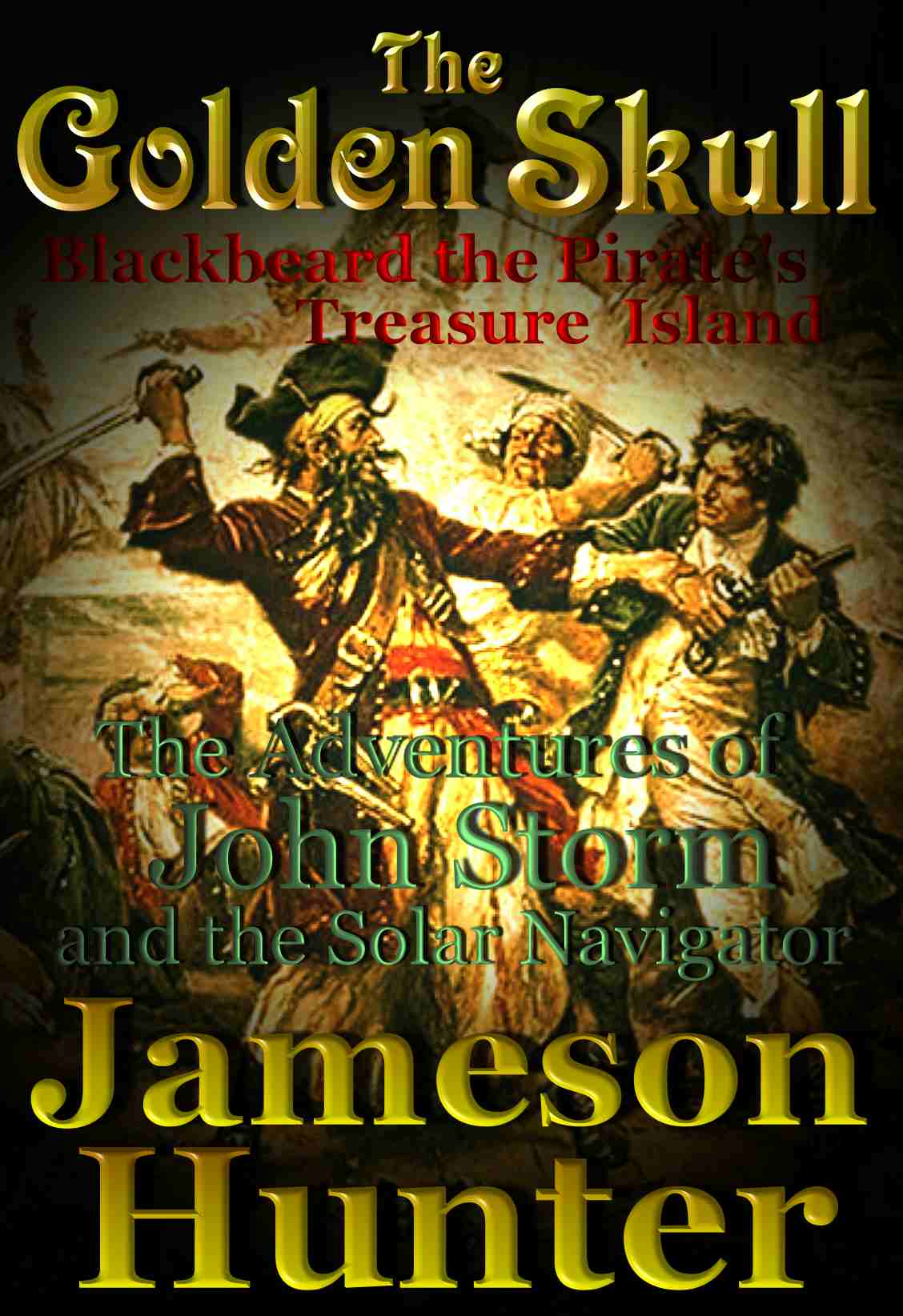
Modern view
- Blackbeard in popular culture
We normally think about pirates as sort of blood-lusting, that they want to slash somebody to pieces. [It's probably more likely that] a pirate, just like a normal person, would probably rather not have killed someone, but pirates knew that if that person resisted them and they didn't do something about it, their reputation and thus their brand name would be impaired. So you can imagine a pirate rather reluctantly engaging in this behavior as a way of preserving that reputation.
Peter Leeson
Official views on pirates were sometimes quite different from those held by contemporary authors, who often described their subjects as despicable rogues of the sea. Privateers who became pirates were generally considered by the English government to be reserve naval forces, and were sometimes given active encouragement; as far back as 1545
Francis Drake was knighted by
Queen
Elizabeth, when he returned to England from a round-the-world expedition with plunder worth an estimated
£1,500,000. Royal pardons were regularly issued, usually when England was on the verge of war, and the public's opinion of pirates was often favourable, some considering them akin to
patrons. Economist Peter Leeson believes that pirates were generally shrewd businessmen, far removed from the modern, romanticised view of them as murderous
tyrants. After Woodes Rogers' 1718 landing at New Providence and his ending of the pirate republic however, piracy in the West Indies fell into terminal decline. With no easily accessible outlet to fence their stolen goods, pirates were reduced to a subsistence livelihood, and following almost a century of naval warfare between the British, French and
Spanish - during which sailors could find easy employment—lone privateers found themselves outnumbered by the powerful ships employed by the British Empire to defend its merchant fleets. The popularity of the
slave trade helped bring to an end the frontier condition of the West Indies and in these circumstances, piracy was no longer able to flourish as it once
did.
Since the end of this so-called golden age of piracy, Teach and his exploits have become the stuff of lore, inspiring books, films and even amusement park rides. Much of what is known about him can be sourced to Charles Johnson's A General Historie of the Robberies and
Murders of the Most Notorious Pyrates, published in Britain in
1724 A recognised authority on the pirates of his time, Johnson's descriptions of such figures as Anne Bonny and Mary Read were for years required reading for those interested in the
subject. Readers were titillated by his stories and a second edition was quickly published, though author Angus Konstam suspects that Johnson's entry on Blackbeard was "coloured a little to make a more sensational
story." A General Historie is though generally considered to be a reliable
source. Johnson may have been an assumed alias. As Johnson's accounts have been corroborated in personal and official dispatches, Lee (1974) considers that whoever he was, he had some access to official
correspondence. Konstam speculates further, suggesting that Johnson may have been the English playwright Charles Johnson, the
British publisher Charles Rivington, or the writer
Daniel
Defoe. In his 1951 work The Great Days of Piracy, author George Woodbury wrote that Johnson is "obviously a pseudonym", continuing "one cannot help suspecting that he may have been a pirate
himself."
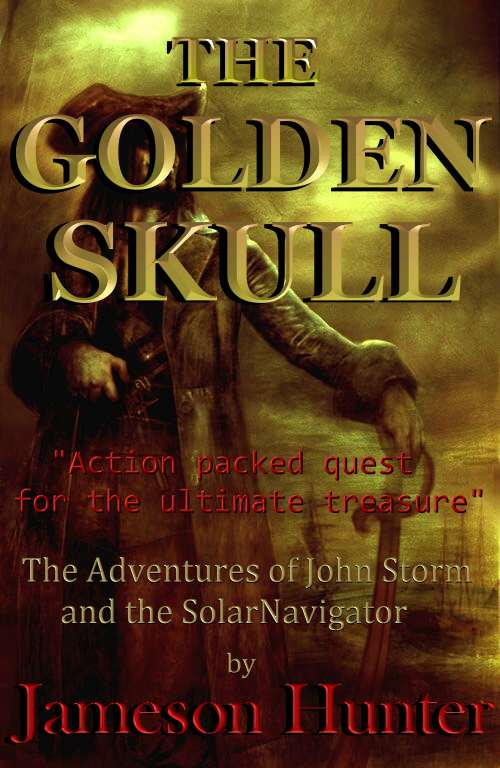
Teach's flag depicted a skeleton spearing a heart, while toasting the devil. Flying such a flag was designed to intimidate one's
enemies. Teach was just as cunning when
concealing his treasure. Even his own men had no idea where he'd stashed
his hoard. A map appears to give no clue to the whereabouts of the gold,
but when John Storm is approached for the hire of his ship, he realizes
one of the symbols and that is enough to persuade him to agree to an
expedition ........
Despite his infamy, Teach was not the most successful of pirates. Henry Every retired a rich man, and Bartholomew Roberts took an estimated five times the amount Teach
stole. Treasure hunters have long busied themselves searching for any trace of his rumoured hoard of
gold and silver, but nothing found in the numerous sites explored along the east coast of the US has ever been connected to him. Some tales suggest that pirates often killed a prisoner on the spot where they buried their loot, and Teach is no exception in these
stories, but that no finds have come to light is not exceptional; buried
pirate treasure is often considered a modern myth for which almost no supporting evidence exists. The available records include nothing to suggest that the burial of treasure was a common practice, except in the imaginations of the writers of fictional accounts such as Treasure Island. Such hoards would necessitate a wealthy owner, and their supposed existence ignores the command structure of a pirate vessel, in which the crew often served by free
suffrage. The only pirate ever known to bury treasure was William
Kidd; the only treasure so far recovered from Teach's exploits is that taken from the wreckage of the Queen Anne's Revenge, which was found and excavated in
1997. As of 2007 more than 15,000 objects have been rescued and preserved, some of which are on display at the North Carolina Maritime
Museum.
Various superstitious tales exist of Teach's ghost. Unexplained lights at sea are often referred to as "Teach's light", and some recitals claim that the notorious pirate now roams the afterlife searching for his head, for fear that his friends, and the
Devil, will not recognise
him. A North Carolinian tale holds that Teach's skull was used as the basis for a silver drinking chalice; a local judge even claimed to have drunk from it one night in the
1930s. The name of Blackbeard has been attached to many local attractions, such as Charleston's Blackbeard's
Cove. His name and persona have also featured heavily in literature. He is the main subject of Matilda Douglas's fictional 1835 work Blackbeard: A page from the colonial history of
Philadelphia. Gregory Keyes' fictional The Age of Unreason has him appearing as the governor of a colony, and Tim Powers' 1988 novel On Stranger Tides tells of his forming an alliance of pirates.
FILMS
Film renditions of his life include:
-
Blackbeard the Pirate (1952),
-
Blackbeard's
Ghost (1968),
-
Blackbeard: Terror at Sea (2005), and the
-
2006 Hallmark Channel miniseries
Blackbeard
Parallels have also been drawn between Johnson's Blackbeard and the character of
Captain Jack Sparrow in the 2003 adventure film, Pirates of the Caribbean: The
Curse of the Black
Pearl.
References:
ACIDIFICATION
- ADRIATIC
- ARCTIC
- ATLANTIC
- BALTIC
- BERING
- CARIBBEAN
- CORAL
- EAST
CHINA
ENGLISH
CH - GOC
- GULF
MEXICO - INDIAN
- MEDITERRANEAN
- NORTH
SEA - PACIFIC
- PERSIAN
GULF - SEA
JAPAN
STH
CHINA - PLASTIC
- PLANKTON
- PLASTIC
OCEANS - SEA
LEVEL RISE - UNEP
MARITIME HISTORY
GENERAL HISTORY
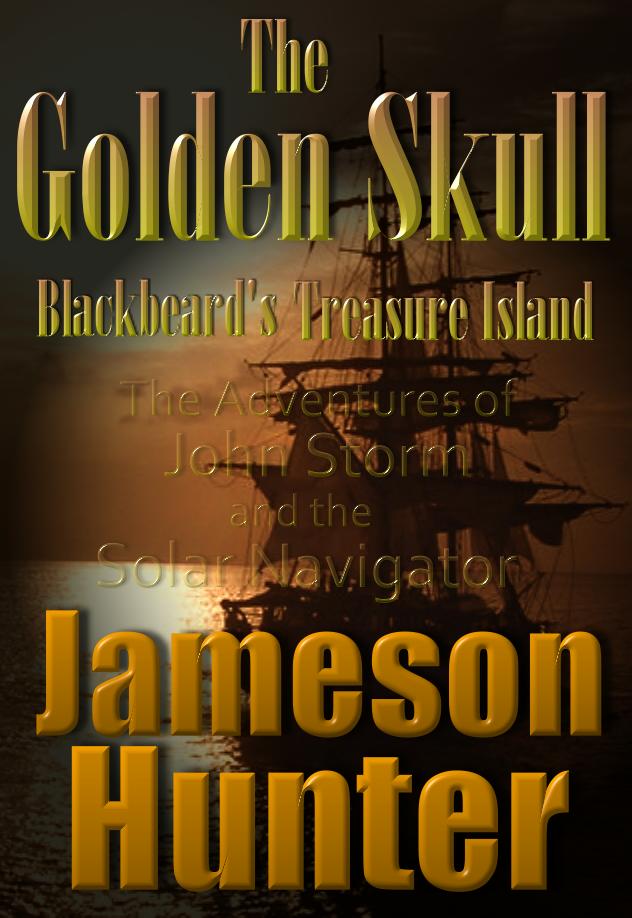
The
most famous treasure hunting yarn is undoubtedly Robert Louis
Stevenson, with
Treasure Island. Many films have been made based on this book and we're sure
that there will be many more to come. A newcomer to the genre is fellow
countryman Jameson Hunter with his "Golden Skull," adventure - also
based in the Caribbean but with a contemporary setting.
|







